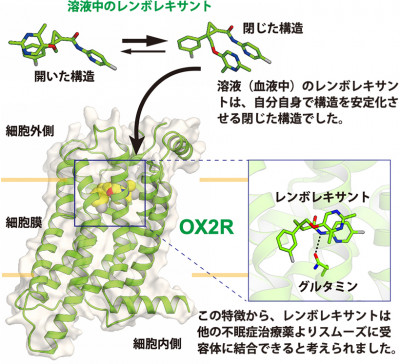2022-11-30 ワシントン大学セントルイス
 A research team, led by scientists at the Center for Clinical Pharmacology at Washington University School of Medicine in St. Louis and the University of Health Sciences & Pharmacy in St. Louis, have altered the chemical properties of fentanyl and the way that it binds to opioid receptors on nerve cells. The goal is to improve the drug’s safety profile without eliminating its ability to alleviate pain. (Photo: Getty Images)
A research team, led by scientists at the Center for Clinical Pharmacology at Washington University School of Medicine in St. Louis and the University of Health Sciences & Pharmacy in St. Louis, have altered the chemical properties of fentanyl and the way that it binds to opioid receptors on nerve cells. The goal is to improve the drug’s safety profile without eliminating its ability to alleviate pain. (Photo: Getty Images)
研究チームは、痛みを和らげる作用をなくすことなく、致死性や習慣性の低い薬にするために、この薬の化学特性および神経細胞のオピオイド受容体との結合方法を変更することに成功した。
マウスとオピオイド受容体を発現する細胞株で行われたこの研究では、改良型薬剤は依然として有効な鎮痛剤であり、致命的な副作用はあまりない可能性があることが示された。
ヘロインやオキシコドンと同様、フェンタニルは神経細胞上のミュー・オピオイド受容体に結合する。フェンタニルなどの薬物は、いったん受容体に取り込まれると、痛みを和らげるだけでなく、血圧を下げ、呼吸を遅くし、呼吸困難や死に至る可能性もある。その他の副作用としては、多幸感、めまい、錯乱、鎮静などがあります。フェンタニルはその強力な作用により、非常に少量であっても特に致死的である。
研究チームは、フェンタニルを改良するにあたり、ミューオピオイド受容体への結合はそのままに、同受容体に存在するナトリウムイオン結合部位に関与するバリエーションを開発した。ナトリウム結合部位を標的にすることで、フェンタニルが痛みに対して作用する経路がわずかに変化し、薬物の鎮痛効果の大部分を維持しつつ、副作用を軽減できることが明らかになった。
この薬物を、痛みを伴う刺激に遭遇したマウスや慢性疼痛モデルマウスで実験したところ、痛みを和らげる作用は維持された。また、標準的な製剤のフェンタニルを投与したマウスに比べ、呼吸抑制が起こりにくく、マウスの行動観察から乱用の可能性が低いことが示唆された。
<関連情報>
- https://source.wustl.edu/2022/11/scientists-alter-fentanyl-aim-to-make-it-less-lethal-less-addictive/
- https://medicine.wustl.edu/news/scientists-alter-fentanyl-with-goal-to-make-it-less-lethal-addictive/
- https://www.nature.com/articles/s41586-022-05588-y
μオピオイド受容体に対するビットプリックリガンドの構造に基づく設計 Structure-based design of bitopic ligands for the µ-opioid receptor
Abdelfattah Faouzi,Haoqing Wang,Saheem A. Zaidi,Jeffrey F. DiBerto,Tao Che,Qianhui Qu,Michael J. Robertson,Manish K. Madasu,Amal El Daibani,Balazs R. Varga,Tiffany Zhang,Claudia Ruiz,Shan Liu,Jin Xu,Kevin Appourchaux,Samuel T. Slocum,Shainnel O. Eans,Michael D. Cameron,Ream Al-Hasani,Ying Xian Pan,Bryan L. Roth,Jay P. McLaughlin,Georgios Skiniotis,Vsevolod Katritch,Brian K. Kobilka & Susruta Majumdar
Nature Published:30 November 2022
DOI:https://doi.org/10.1038/s41586-022-05588-y
We are providing an unedited version of this manuscript to give early access to its findings. Before final publication, the manuscript will undergo further editing. Please note there may be errors present which affect the content, and all legal disclaimers apply.
Abstract
Mu opioid receptor (µOR) agonists like fentanyl have long been used for pain management, but are considered a major public health concern due to their adverse side effects, including lethal overdose.1 To design safer therapeutics, we report a conceptually novel approach targeting conserved sodium (Na+) binding site2, observed in µOR3 and many other class A GPCRs, by bitopic fentanyl derivatives functionalized via a linker with a positively charged guanidino group. Cryo-EM structures of the most potent bitopic ligands in complex with µOR highlight the key interactions between the ligand’s guanidine and the key Asp2.50 residue in the Na+ site. While the lead bitopics maintain nanomolar potency and high efficacy at Gi subtypes, they show strongly reduced arrestin recruitment, one also shows the lowest Gz-efficacy among the panel of µOR agonists, including partial and biased, morphinan and fentanyl analogs. In mice, the best bitopic ligand displayed µOR dependent antinociception with attenuated adverse effects supporting the µOR Na+ site as a potential target for the design of safer analgesics. In general, our study suggests that bitopic ligands engaging the Na+ pocket in class A GPCRs can be designed to control their efficacy and functional selectivity profiles for Gi/o/z subtypes and arrestins, thus modulating their in vivo pharmacology.


